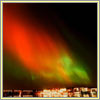

|
|
The aurora borealis, or northern lights, illuminates the sky
over Stockholm on April 6, 2000. The red and yellow-green
colors of this auroral display are due to oxygen gas hovering
at two different altitudes. Oxygen in the atmosphere more than
150 miles above the surface of the Earth glows red when
exposed to fast-moving particles from the magnetosphere, while
oxygen 150 miles away or closer appears yellow-green or green,
the brightest and most common auroral hue.
|
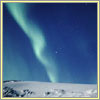

|
|
The aurora borealis is seen here over Iceland's Vatnajokull
Ice Cap, the largest ice cap in Europe, on February 15, 1999.
The aurora appears in a band shape and gets its blue color
from nitrogen 60 miles or less above the Earth's surface.
There are many other auroral forms—coronas, rays,
spirals, and arcs, to name a few. Observers of auroras
sometimes think that the variety of shapes corresponds to
fluctuating weather conditions. In reality, auroras take on
roughly the same shape each time they appear, but they look
different depending on the viewer's perspective. (They can
sometimes also be blown by the wind.)
|
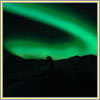

|
|
A brilliant green section of the aurora borealis in its arc
form shines over the skies of the Alaskan wilderness, a prime
spot for aurora watching. This aurora occurred in the fall,
when sky-watchers often report seeing auroras. Scientists
don't yet know why, but geomagnetic storms that ignite auroras
tend to happen more frequently during the months surrounding
the fall and spring equinoxes. Green auroras like this one are
the result of energized oxygen located 150 miles or less above
Earth's surface.
|
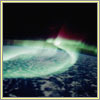

|
|
In April 1991 the space shuttle Discovery photographed
this display of the aurora australis, or southern lights, over
the Antarctic region. From above, you can see the magnetic
field lines, a series of vortices in the Earth's magnetic
field, along which electrons and protons move as they burst
into the atmosphere. When space weather pours energy towards
Earth and energizes its magnetic field, particles flow and
collect at both ends of these field lines, culminating in
2,500-mile-wide rings encircling each pole.
|
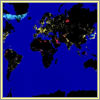

|
|
This color-coded image of our world at night during a display
of the aurora borealis in 2001 shows on average the position
of the northern lights. The aurora appears in light blue. The
other colors represent city lights (yellow), oil production
flares (red), burning vegetation (purple), and squid-fishing
boats (green).
|
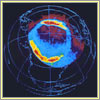

|
|
NASA's UltraViolet Imager, an instrument on the Polar
spacecraft, captured this image of the aurora borealis'
distribution across the North Pole on April 6, 1996.
Remarkably, it shows auroral activity in both the night and
day hemispheres of Earth at the same time—the daytime
side being the Western Hemisphere, which is visible in the
lower part of the image. Though reflected sunlight would drown
out the daytime aurora in a visible light image, ultraviolet
light picks it up. The intensity of the aurora's concentration
is color-coded from purple (weakest) through blue, green,
yellow, and red (strongest). A sub-aurora, the large red area
that appears in the upper part of the image, displays mostly
in the night sky.
|
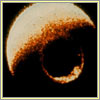

|
|
On September 15, 1998, the NASA Dynamics Explorer 1 satellite
recorded this image, the first of its kind showing the
complete loop of the aurora borealis encircling the North
Pole. The bright area in the upper left of the image is the
sunlit portion of Earth.
|
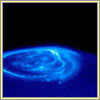

|
|
Half a billion miles away from Earth, this blue aurora glows
in the atmosphere around Jupiter. Taken by the Hubble Space
Telescope on December 14, 2000, the image shows the aurora
centered over the planet's magnetic north pole. Auroral
displays have been observed on Jupiter, Saturn, Uranus, and
Neptune, as well as on the moons of these planets. The process
for generating auroras is the same throughout the solar
system; the only requirements for auroras are the presence of
a magnetosphere and an atmosphere. Interestingly enough,
Jupiter's moon Io does not have an atmosphere surrounding it,
but its many active volcanoes on can create a temporary
atmosphere around them when they erupt, allowing for eerie,
ground-level auroras.
|
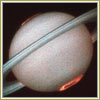

|
|
The Hubble Space Telescope took this colored ultraviolet image
of auroras at both of Saturn's poles in 2000.
|
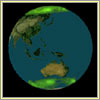

|
|
On September 16, 1770, while exploring the South Pacific on
the HMS Endeavour, Captain James Cook saw what he
described in his diary as "a phenomenon...in the heavens in
many things resembling the Aurora Borealis." On the flip side
of the Earth, in the Northern Hemisphere, residents of
northern China observed an aurora on the same night. (The
event was recorded in the Qingshi Gao, a Qing Dynasty
almanac.)
Scientists have long suspected that auroras in the Northern
and Southern hemispheres are conjugates, or mirror images,
occurring at the same time. But hard evidence eluded them. For
two decades, NASA studied the auroras and tried to capture an
image of simultaneous auroral loops at both poles. Finally,
their Polar spacecraft filmed this movie on October 22, 2001.
It shows the auroras dancing around both poles at the same
time. Analysis of the movie has shown that while the auroras
appear to be mirror images, they have subtle details that do
differentiate the two.
|

|

|

